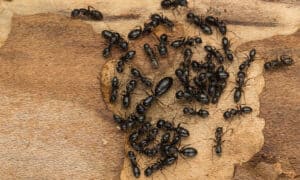Step into the bustling world of Massachusetts during the vibrant summer months, where the ground beneath your feet becomes a miniature metropolis teeming with life. As the temperature rises, a remarkable phenomenon unfolds the emergence of various types of ants. These tiny creatures, each with their unique traits and roles, embark on a bustling journey of foraging, building, and maintaining their intricate colonies.
In this article, we’ll uncover the captivating types of ants set to emerge in Massachusetts this summer.
Asian Needle Ant (Brachyponera chinensis)
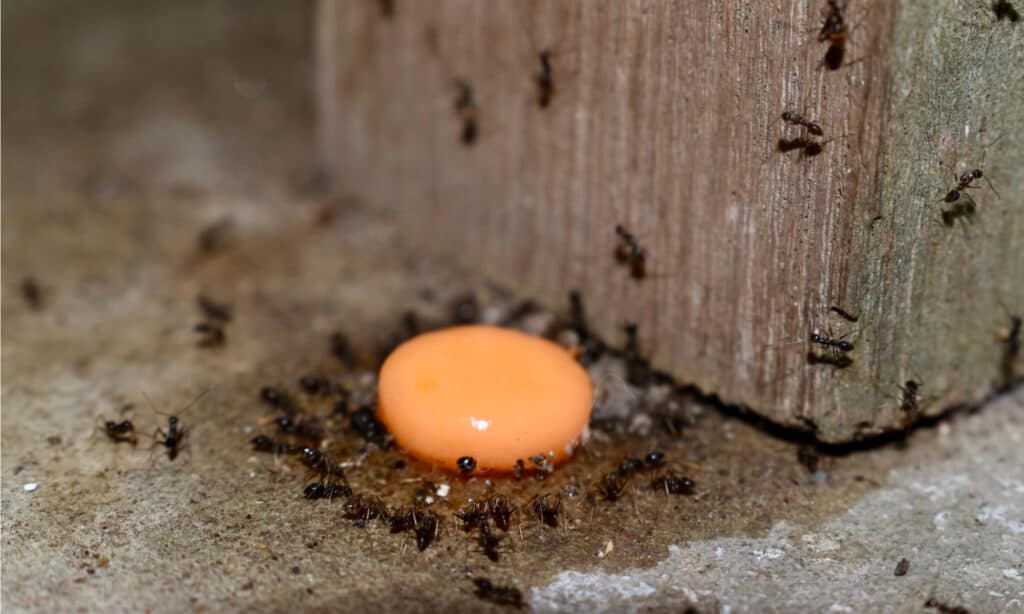
The individuals of this species are rather slim, sporting a dark brown to black hue.
©Zay Nyi Nyi/Shutterstock.com
Let’s dive into the intriguing world of the invasive Asian needle ant, the first ant species we’ll be exploring in Massachusetts. While it was initially reported in the United States back in the early 1930s, it only gained recognition as a pest here in 2006. Originating from Asia, this ant possesses a unique set of characteristics.
The individuals of this species are rather slim, sporting a dark brown to black hue. However, their legs and mandibles stand out with a lighter brown to orange-ish coloration. Interestingly, one distinct feature that sets the Asian needle ant apart from other ants is its inability to cling to smooth surfaces like glass. On average, these workers measure about 0.2 inches in length, making them relatively small in size.
When it comes to nesting preferences, the Asian needle ant favors dark and damp areas within the soil. You can find them taking shelter beneath stones, logs, stumps, and other debris. As for their diet, these ants primarily feed on deceased insects, fish scraps, and decaying fruit. However, they also have a taste for live arthropods, including termites.
The busy season for Asian needle ant workers begins in March and continues until late October. During the period from late May to September, you’ll notice swarmers, but the majority of swarming activity occurs in July and August.
American Carpenter Ant (Camponotus americanus)
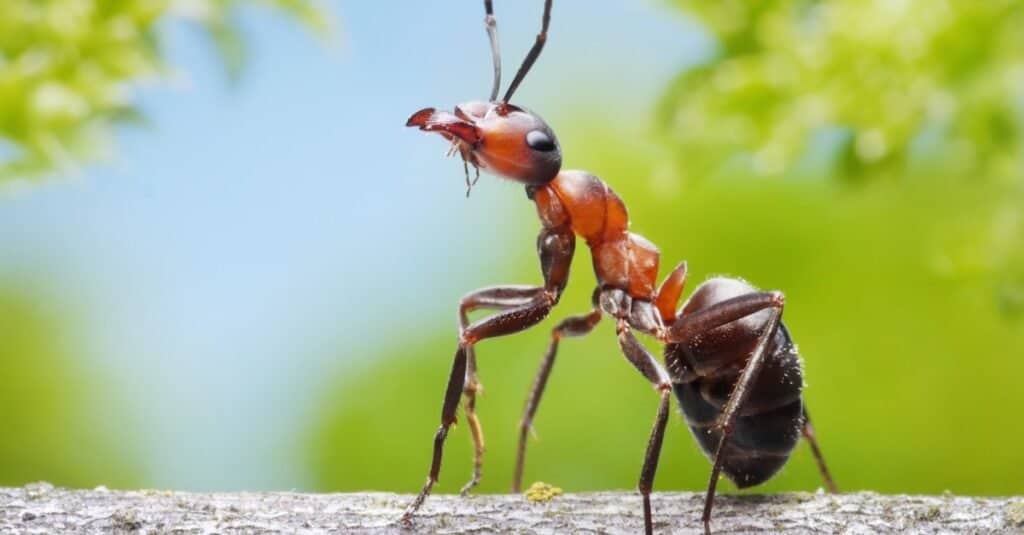
These fascinating creatures sport a dark-colored head that contrasts with their reddish-brown bodies.
©iStock.com/Antrey
One of the most common ant species in Massachusetts is the American carpenter ant.
These fascinating creatures sport a dark-colored head that contrasts with their reddish-brown bodies. While they may seem intimidating due to their size, you’ll be relieved to know that they are unlikely to invade your home, preferring to make their nests outdoors.
American carpenter ants are talented architects and can construct nests in various materials such as wood, soil, rotting logs, and even under stones. These large ants have a diverse palate, feasting on both protein and sugar sources. Out in the wild, they enjoy indulging in living and dead insects and have a particular fondness for honeydew.
In the beautiful state of Massachusetts, American carpenter ants wake up from their winter slumber in the spring, usually around March or April. Their activity continues throughout the warm months until early fall in September or October. During this time, a mature carpenter ant colony will release reproductive individuals, ensuring the survival and expansion of their species.
Allegheny Mound Ant (Formica exsectoides)
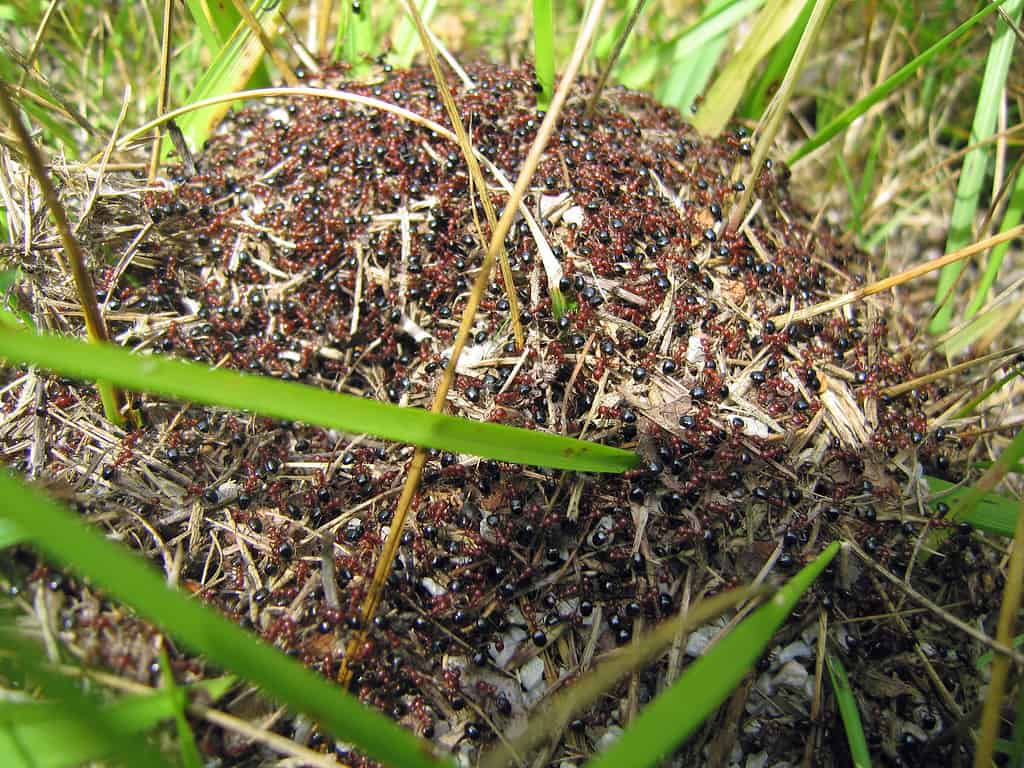
The colonies of Allegheny mound ants are incredibly complex.
©Allegheny Mound Ants, Formica exsectoides – License
The Allegheny mound ants of Massachusetts are famous for their impressive mound nests, making them easy to spot in the region.
Within a single colony of these ants, you can find one or even multiple queens. Both the queens and the workers possess a striking coloration, with reddish-orange heads and thoraxes, accompanied by black abdomens and legs. When it comes to size, workers vary in length from 1/8 to 1/4 of an inch.
These fascinating ants prefer to live in fields, pastures, and wooded areas as their preferred habitats. However, they are not limited to natural settings alone; you may also find them residing in playgrounds and residential lawns in both rural and suburban areas.
They consume both living and deceased insects, showcasing their predatory nature. Additionally, they have a taste for the sweet honeydew produced by aphids and mealy bugs that reside in trees.
If you’re hoping to catch a glimpse of these remarkable ants in Massachusetts, the prime time to spot them is from April until September or early October. It’s worth noting that most new colonies typically emerge in late May and early June.
European Fire Ant (Myrmica rubra)

European fire ants have a preference for sugar or honey-based water.
©thomaslabriekl/Shutterstock.com
The European fire ant, initially identified in Massachusetts in 1908, is a captivating species known for its invasive nature and potential risks to both health and ecology in the United States.
With their reddish-brown appearance, European fire ants display remarkable variation in coloration among individuals and colonies. These tiny workers measure a mere 3/16 inches and possess a distinctive two-segmented waist. Delicate hairs cover the worker’s body, adding to their unique features.
These ants create nests beneath various forms of debris found on lawns, such as rocks, boards, logs, and other materials that retain moisture. In terms of diet, European fire ants have a preference for sugar or honey-based water. But they’ll also eat small invertebrates, such as insects and spiders. Their culinary interests extend to fruits like apples and pears.
When their nests are disturbed, European fire ants exhibit defensive behavior.
Spring and fall are the peak seasons of activity for European fire ants, coinciding with warm soil and mild weather conditions. During late June, reproductive ants emerge, though it is important to note that not all individuals in fire ant colonies possess wings, distinguishing them from pavement ants and carpenter ants.
Thief Ant (Solenopsis molesta)

Their name, thief ant, derives from their fascinating habit of establishing nests near, and sometimes even inside, the dwellings of other ants.
©Mathisa/Shutterstock.com
Thief ants, those sneaky little creatures, are experts at remaining undetected within Massachusetts homes. Measuring a mere 1/16 inch in length, these monomorphic workers possess a subtle yellowish or tan hue, often lighter than other diminutive ant species.
Their name, thief ant, derives from their fascinating habit of establishing nests near, and sometimes even inside, the dwellings of other ants. They have a habit of stealing food from their unwitting neighbors. They dig tunnels that serve as secret passageways, linking them to the nearby nests of larger ants, which become frequent targets of their larcenous activities.
In terms of diet, thief ants are not picky eaters. They eat almost anything organic that comes their way. Their diet includes insects and deceased arthropods.
When it comes to their reproductive habits, thief ants engage in mating swarms, known as nuptial flights, starting in late July and continuing until early fall. Although they emerge throughout the spring and summer months, spotting these elusive creatures poses quite a challenge due to their diminutive size.
Other Insects Set To Emerge In Massachusetts
Let’s look at some other species of insect set to emerge in Massachusetts this summer.
Brown Marmorated Stink Bug (Halyomorpha halys)
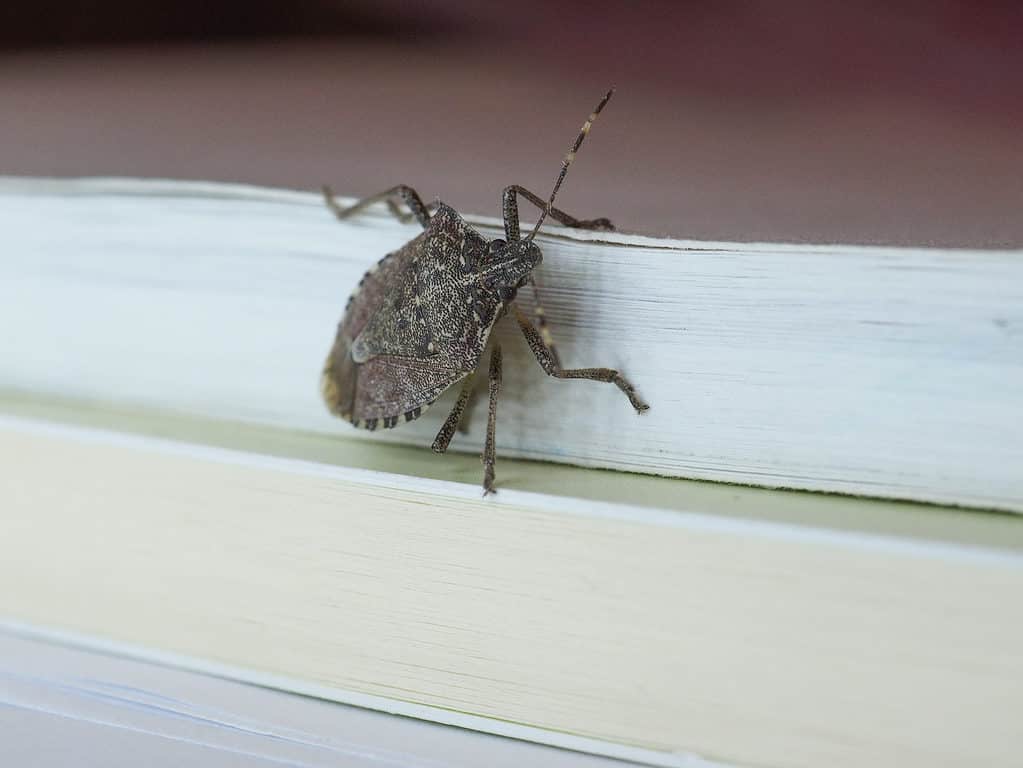
One distinctive feature of the brown marmorated stink bug is its shield-shaped body, which is typical of all stink bugs.
©Claudio Divizia/Shutterstock.com
The brown marmorated stink bug, an invasive pest, made its first appearance in Massachusetts back in 2007. Originating from Asia, this troublesome insect found its way to the United States through shipments of trade goods. They have caused a lot of trouble for local ecosystems.
One distinctive feature of the brown marmorated stink bug is its shield-shaped body, which is typical of all stink bugs. With a length of approximately half an inch to 5/8 of an inch, these adult bugs sport a mottled brownish-grey color. When you flip them over, you’ll notice their white underside, sometimes adorned with grey or black markings, while their brown legs exhibit faint white banding.
These sneaky stink bugs have quite an appetite and can feast on a wide range of plant materials. They enjoy ornamental plants, fruits, and vegetable crops. When threatened, these bugs emit a pungent and malodorous chemical that acts as their defense mechanism.
From May to June, you might spot these bugs, and their presence can linger until September.
Deer Fly (Chrysops)
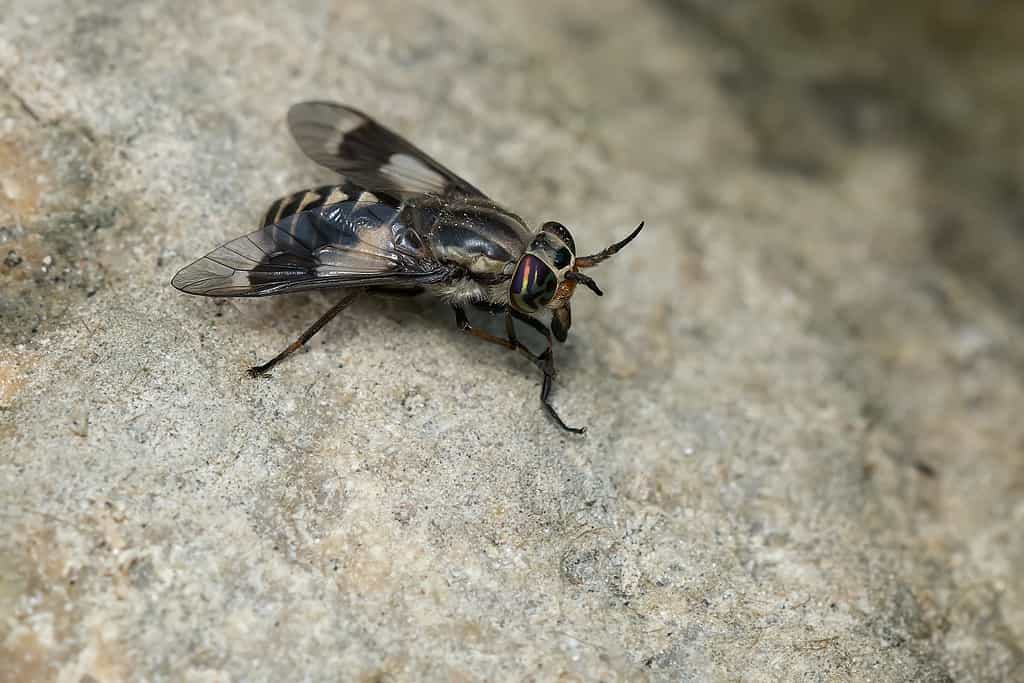
Equipped with razor-sharp mouthparts, deer flies inflict a painful bite on unsuspecting victims.
©Paul Reeves Photography/Shutterstock.com
Swarms of deer flies can strike fear into the hearts of Massachusetts residents. Particularly concerning those residing along the scenic coast, where these buzzing pests tend to gather in great numbers.
These elusive insects measure between ¼ to 1/3 inches in length. They sport wings that are transparent yet adorned with dark bands or patches. Their bodies come in shades of gray or light brown, with some species showcasing striking yellow and black stripes. Notably, their antennae are often longer than their heads, adding to their peculiar appearance.
Equipped with razor-sharp mouthparts, deer flies inflict a painful bite on unsuspecting victims. While the effects of their bites are usually short-lived, some individuals may experience allergic reactions to them. What’s more concerning is that these bothersome flies occasionally carry diseases such as tularemia, which can be transmitted to humans through their bites.
Prepare yourself, as deer flies are most active from May through September. So, be vigilant during these warm months and protect yourself from their persistent presence.
Six-Spotted Tiger Beetle (Cicindela sexguttata)
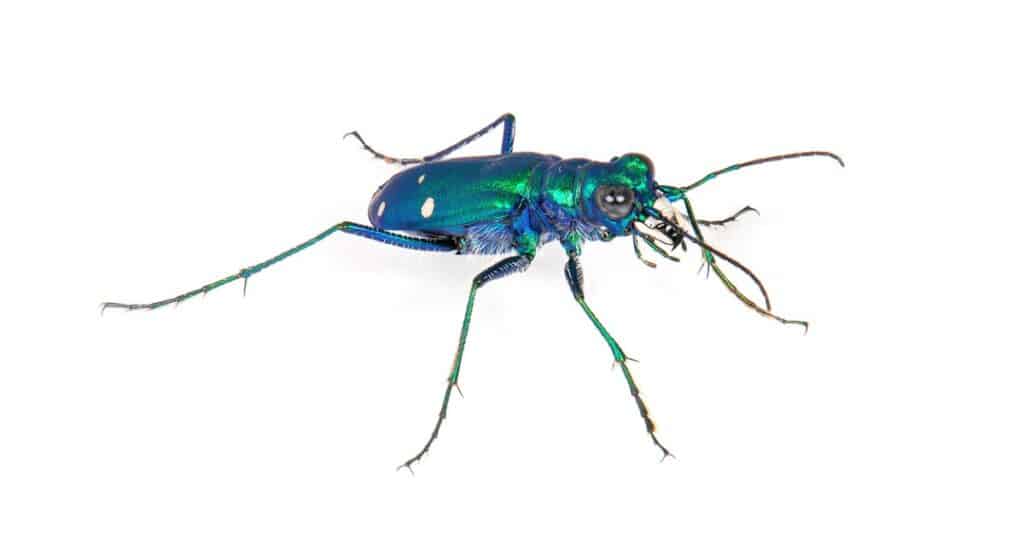
The activity of the six-spotted
tiger
beetles spans from the refreshing season of spring to the early days of summer.
©ianmwright86/Shutterstock.com
The six-spotted tiger beetle is a fascinating species native to North America. They can easily be identified by their vibrant green hue. Their impressive speed both on land and in the air also identifies them. Catching just a fleeting glimpse of this remarkable creature is enough to recognize it by its shiny emerald appearance and its swift movements.
Sporting a striking metallic green or sometimes blue coloration, the six-spotted tiger beetle stands out with its long legs, distinctive sickle-shaped mandibles, and large bulging eyes. These adult beetles typically measure between ⅜” to 9⁄16″ in length, showcasing their compact yet captivating form.
While these tiger beetles are known for their insatiable appetite for small arthropods, they pose no threat to humans unless provoked or handled. Preferring a solitary lifestyle, they are commonly found along trails, dirt paths, and sunlit patches on the forest floor, often near the forest’s edge. These strategic locations offer them ample opportunities to hunt and thrive.
The activity of the six-spotted tiger beetles spans from the refreshing season of spring to the early days of summer. Interestingly, the adults of this species spend the winter months nestled in their larval burrows. They are patiently awaiting the arrival of the warmer seasons.
Eastern Carpenter Bee (Xylocopa virginica)
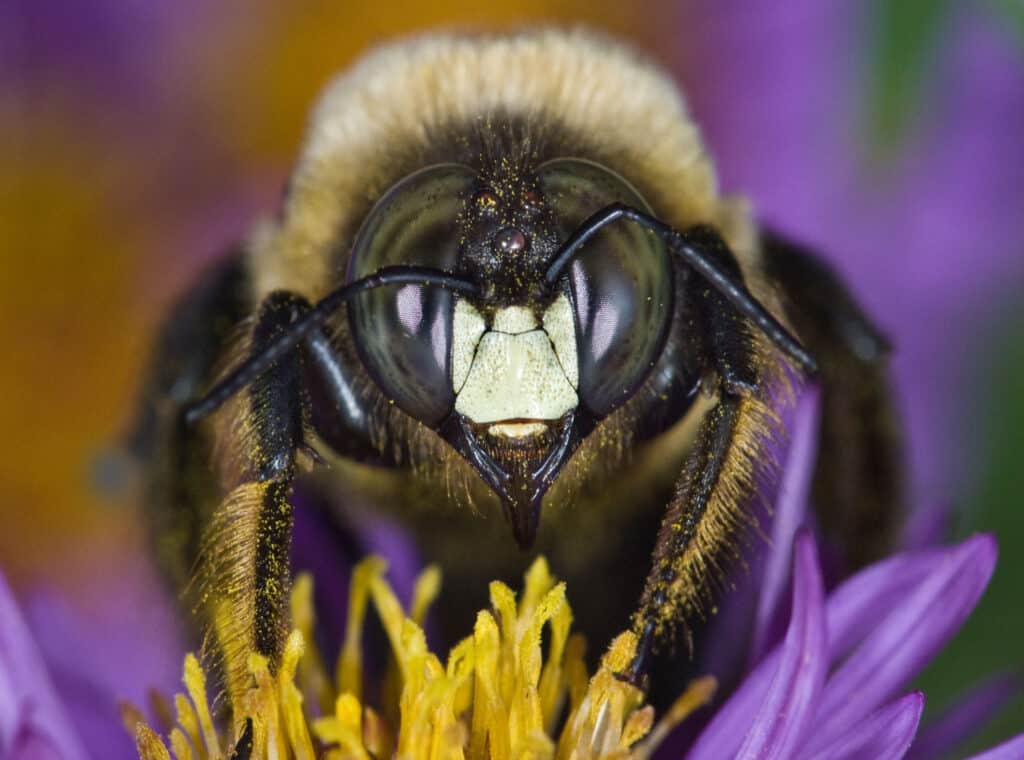
Carpenter bees have large eyes and a glossy, hairless abdomen.
©Gerry Bishop/Shutterstock.com
Introducing the notorious eastern carpenter bee species found in Massachusetts. They are known to be the most destructive of their kind in the entire United States!
These bees bear a striking resemblance to a bumblebee, except for its shiny black abdomen that catches the eye. Remarkably, the male eastern carpenter bees sport white faces and, interestingly, cannot sting, much like other male bees.
These intriguing creatures differ from termites in that they don’t consume wood. Instead, they meticulously carve out tunnels in wood for the sole purpose of building their nests and ensuring successful reproduction. However, this excavating activity poses a significant threat to the integrity of structural wood. It renders floorboards, decks, and patios susceptible to potential collapse.
While the damage they inflict on wood is a serious concern, the eastern carpenter bees also manage to make their presence known to the residents of Massachusetts during the warmer months. Although the male carpenter bees lack stingers, their curious behavior of swiftly darting towards anyone making sudden movements can be quite alarming.
As for the female carpenter bees, they do possess the ability to sting humans. Such incidents are rare as it takes a significant provocation to incite them to use their stingers against us.
If you happen to find yourself in Massachusetts during spring or summer, keep an eye out for these industrious creatures buzzing around residential areas.
Summary Of The Types Of Ants Set To Emerge In Massachusetts This Summer
| Ant | Months Active |
| Asian Needle Ant | March – October |
| American Carpenter Ant | March – October |
| Allegheny Mound Ant | April – October |
| European Fire Ant | March – October |
| Thief Ant | March – October |
The photo featured at the top of this post is © Lukas Jonaitis/Shutterstock.com
Thank you for reading! Have some feedback for us? Contact the AZ Animals editorial team.




